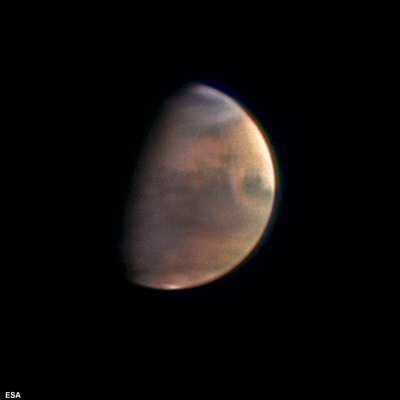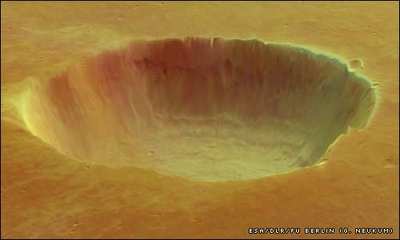Mars Express Taking Radar Pictures Of Martian Surface
 Marsis, the sounding radar onboard
ESA's Mars Express spacecraft, is collecting the first data about
the surface and ionosphere of Mars.
Marsis, the sounding radar onboard
ESA's Mars Express spacecraft, is collecting the first data about
the surface and ionosphere of Mars.
This radar started its science operations on July 4th, the same
day as its first commissioning phase ended. Due to the late
deployment of Marsis, it was decided to split the commissioning,
originally planned to last four weeks, into two phases; the second
will take place in December. It has thus been possible to begin
scientific observations with the instrument earlier than initially
planned, while it is still Martian night-time. This is the best
environmental condition for subsurface sounding, as in daytime the
ionosphere is more "energized" and disturbs the radio signals used
for subsurface observations.
As from the start of commissioning, the two 20m-long antenna
booms have been sending radio signals towards the Martian surface
and receiving echoes back. "The commissioning procedure confirmed
that the radar is working very well and that it can be operated at
full power without interfering with any of the spacecraft systems,"
says Roberto Seu, Instrument Manager for Marsis, of University of
Rome "La Sapienza," Italy.
Marsis is a very complex instrument, capable of operating at
different frequency bands. Lower frequencies are best suited to
probing the subsurface, the highest frequencies are used to probe
shallow subsurface depths, while all frequencies are suited to
studying the surface and the upper atmospheric layer of Mars.
"During commissioning we worked to test all transmission modes and
optimize the radar's performance around Mars," says Professor
Giovanni Picardi, Principal Investigator for Marsis, of University
of Rome "LaSapienza."
"The result is that since we started the scientific observations
in early July, we have been receiving very clean surface echoes
back, and first indications about the ionosphere."
The Marsis radar is designed to operate around the orbit
"pericenter," when the spacecraft is closer to the planet's
surface. In each orbit, the radar is switched on for 36-minutes
around this point, spending the middle 26-minutes on subsurface
observations and the first and last five minutes of the slot on
active ionosphere sounding.

Using the lower frequencies, Marsis has been mainly
investigating the northern flat areas between the 30� and
70� latitudes, at all longitudes. "We are very satisfied
with the way the radar is performing. In fact, the surface
measurements taken so far match almost perfectly the existing
models of the Mars topography," said Prof. Picardi. Thus, these
measurements have proved to be an excellent test. The scientific
reason for concentrating on flat regions with the first data
analysis is the fact that the subsurface layers are in principle
easier to identify, though the task is still a tricky one. "As the
radar appears to work so well for the surface, we have good reason
to think the radio waves are also propagating correctly below the
surface," added Prof. Picardi.
"The bulk of our work has just started, as we now have to be
sure to clearly identify and isolate the echoes coming from the
subsurface. To do this, we have to carefully screen all data and
make sure that signals which could be interpreted as coming from
different underground layers are not actually produced by surface
irregularities. This will keep us occupied for a few more weeks at
least."
The first ionospheric measurements performed by Marsis have also
led to some interesting preliminary findings. The radar responds
directly to the number of charged particles composing the
ionosphere (plasma). This has at times been shown to be higher than
expected."We are now analyzing the data to find out if such
measurements may result from sudden increases in solar activity,
such as the one observed on July 14th, or if we have to put forward
new hypotheses. Only further analysis of the data can tell us,"
said Jeffrey Plaut, co-Principal Investigator, from the NASA Jet
Propulsion Laboratory, Pasadena, USA.
Marsis will carry on sending signals that hit the surface and
penetrate the subsurface until the middle of August, when the
night-time portion of the observations will have almost ended.
After that, observation priority will be given to other Mars
Express instruments that are best suited to operating in daytime,
such as the HRSC camera and Omega mapping spectrometer. However,
Marsis will continue its surface and ionospheric investigations in
daytime, with ionospheric sounding being reserved for more than 20%
of all Mars Express orbits, under all possible Sun illumination
conditions.
In December, the Mars Express orbit pericenter will enter
night-time again. By then, the pericenter will have moved closer to
the south pole, allowing Marsis to carry out optimal probing of the
subsurface once again, this time in the southern hemisphere.
The first commissioning phase was given over to testing the
Marsis electronics and software and the two 20m-long antennas
(dipole). The second commissioning phase, lasting about ten days,
will be spent calibrating the 7m monopole antenna. This antenna is
to be used in conjunction with the Marsis dipole to correct any
surface roughness effects caused by the radio waves emitted by the
dipole and reflected by an irregular surface. The monopole will
find its best use during investigations of areas where surface
roughness is greater.

The Marsis instrument was developed within the framework of a
Memorandum of Understanding between the Italian Space Agency (ASI)
and NASA. It was developed by Alenia Spazio under ASI management
and the scientific supervision of University of Rome "La Sapienza,"
in partnership with the Jet Propulsion Laboratory (JPL) and the
University of Iowa. JPL provided the antenna manufactured by Astro
Aerospace. It is the first instrument designed to actually look
below the surface of Mars.
Its major goals are to characterize the subsurface layers of
sediments and possibly detect underground water or ice, conduct
large-scale altimetry mapping and provide data on the planet's
ionosphere.
For subsurface probing, Marsis must operate between 300 km and
800 km from the Martian surface, while for ionospheric sounding, it
has already provided satisfactory results from a distance of up to
3000 km. Radar vertical resolution is about 150m (in free space),
while horizontal resolution, in the range of a few kilometers,
depends on the spacecraft's altitude.
The joint Italian and American Marsis team is also largely
involved in the Sharad radar, a facility instrument provided by ASI
for NASA's Mars Reconnaissance Orbiter (MRO), due for launch in
August. Marsis and Sharad are two radars designed to provide
complementary information about the Martian subsurface. Marsis can
penetrate to an average depth of 5km, while Sharad will concentrate
on layers closer to the surface.
 ANN's Daily Aero-Linx (05.06.25)
ANN's Daily Aero-Linx (05.06.25) ANN's Daily Aero-Term (05.06.25): Ultrahigh Frequency (UHF)
ANN's Daily Aero-Term (05.06.25): Ultrahigh Frequency (UHF) ANN FAQ: Q&A 101
ANN FAQ: Q&A 101 Classic Aero-TV: Virtual Reality Painting--PPG Leverages Technology for Training
Classic Aero-TV: Virtual Reality Painting--PPG Leverages Technology for Training Airborne 05.02.25: Joby Crewed Milestone, Diamond Club, Canadian Pilot Insurance
Airborne 05.02.25: Joby Crewed Milestone, Diamond Club, Canadian Pilot Insurance





